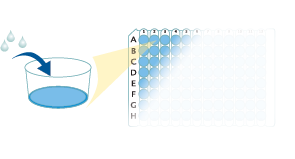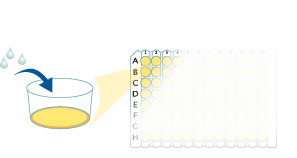Mouse TSLP Quantikine ELISA Kit Summary
Product Summary
Precision
Cell Culture Supernates, Serum, EDTA Plasma, Heparin Plasma
| Intra-Assay Precision | Inter-Assay Precision | |||||
|---|---|---|---|---|---|---|
| Sample | 1 | 2 | 3 | 1 | 2 | 3 |
| n | 20 | 20 | 20 | 31 | 31 | 31 |
| Mean (pg/mL) | 45 | 70 | 167 | 50 | 84 | 189 |
| Standard Deviation | 2.5 | 3.2 | 8.5 | 3.8 | 8.2 | 12.9 |
| CV% | 5.6 | 4.6 | 5.1 | 7.6 | 9.8 | 6.8 |
Recovery
The recovery of mouse TSLP spiked to three levels throughout the range of the assay in various matrices was evaluated.
| Sample Type | Average % Recovery | Range % |
|---|---|---|
| Cell Culture Supernates (n=6) | 103 | 93-114 |
| EDTA Plasma (n=4) | 94 | 80-108 |
| Heparin Plasma (n=5) | 96 | 89-119 |
| Serum (n=5) | 92 | 87-101 |
Linearity
Scientific Data
Product Datasheets
Preparation and Storage
Background: TSLP
Thymic Stromal Lymphopoietin (TSLP) was originally identified as an activity from the conditioned medium of a mouse thymic stromal cell line that promoted the development of B cells. The activities of mouse TSLP overlap with, but are distinct from, those of mouse IL-7. Both mouse TSLP and IL-7 can co-stimulate growth of thymocytes and mature T cells, and support B lymphopoiesis in long-term cultures of fetal liver cells and bone-marrow cells. Whereas mouse IL-7 facilitates the development of B220+/IgM- pre-B cells, mouse TSLP promotes the development B220+/IgM+ B cells. Human TSLP was reported to preferentially stimulate myeloid cells, inducing the release of T cell-attracting chemokines from monocytes and enhancing the maturation of CD11c+ dendritic cells. Human TSLP cDNA encodes a 159 amino acid (aa) residue precursor protein with a 28 aa signal sequence. Within the mature region, six of the seven cysteine residues present in the mouse TSLP involved in intramolecular disulfide bond formation are conserved in the human TSLP. Human TSLP shares approximately 43% aa sequence identity with mouse TSLP. By Northern blot analysis, human TSLP expression has been detected in many tissues with the highest expressions in heart, liver, testis and prostate. TSLP signals through a heterodimeric receptor complex that consists of IL-7 R alpha and the TSLP R, a member of the hemopoietin receptor family most closely related to Rgammac.
TSLP R, also named Delta and CRLM-2 (Cytokine Receptor-like Module-2), was originally cloned as a novel type 1 cytokine receptor with similarity to the common gamma chain (gamma c). It was subsequently identified as a subunit of the cellular receptor for the IL-7-like cytokine TSLP and termed TSLP R. TSLP R shows 24% sequence identity with the mouse gc receptor. TSLP R expression is constitutive in immune and hematopoietic cells, but is up-regulated in Th2 cells.
Assay Procedure
Refer to the product- Prepare all reagents, standard dilutions, and samples as directed in the product insert.
- Remove excess microplate strips from the plate frame, return them to the foil pouch containing the desiccant pack, and reseal.
- Add 50 µL of Assay Diluent to each well.
- Add 50 µL of Standard, Control, or sample to each well. Cover with a plate sealer, and incubate at room temperature for 2 hours.
- Aspirate each well and wash, repeating the process 4 times for a total of 5 washes.
- Add 100 µL of Conjugate to each well. Cover with a new plate sealer, and incubate at room temperature for 2 hours.
- Aspirate and wash 5 times.
- Add 100 µL Substrate Solution to each well. Incubate at room temperature for 30 minutes. PROTECT FROM LIGHT.
- Add 100 µL of Stop Solution to each well. Read at 450 nm within 30 minutes. Set wavelength correction to 540 nm or 570 nm.





Citations for Mouse TSLP Quantikine ELISA Kit
R&D Systems personnel manually curate a database that contains references using R&D Systems products. The data collected includes not only links to publications in PubMed, but also provides information about sample types, species, and experimental conditions.
28
Citations: Showing 1 - 10
Filter your results:
Filter by:
-
The microbiota and T cells non-genetically modulate inherited phenotypes transgenerationally
Authors: Harris, JC;Trigg, NA;Goshu, B;Yokoyama, Y;Dohnalová, L;White, EK;Harman, A;Murga-Garrido, SM;Ting-Chun Pan, J;Bhanap, P;Thaiss, CA;Grice, EA;Conine, CC;Kambayashi, T;
Cell reports
Species: Mouse, Transgenic Mouse
Sample Types: Serum
-
Fallopia japonica Root Extract Ameliorates Ovalbumin-Induced Airway Inflammation in a CARAS Mouse Model by Modulating the IL-33/TSLP/NF-?B Signaling Pathway
Authors: Jin, J;Fan, YJ;Nguyen, TV;Yu, ZN;Song, CH;Lee, SY;Shin, HS;Chai, OH;
International journal of molecular sciences
Species: Mouse
Sample Types: BALF, NLF
-
Increased hepatic interleukin-1, arachidonic acid, and reactive oxygen species mediate the protective potential of peptides shared by gut cysteine peptidases against Schistosoma mansoni infection in mice
Authors: H Tallima, R El Ridi
PloS Neglected Tropical Diseases, 2023-03-15;17(3):e0011164.
Species: Mouse
Sample Types: Tissue Homogenates
-
Crosstalk between ILC2s and Th2 cells varies among mouse models
Authors: RK Gurram, D Wei, Q Yu, MJ Butcher, X Chen, K Cui, G Hu, M Zheng, X Zhu, J Oh, B Sun, JF Urban, K Zhao, WJ Leonard, J Zhu
Cell Reports, 2023-02-02;42(2):112073.
Species: Mouse
Sample Types: BALF
-
Downregulation of deubiquitinating enzyme USP25 promotes the development of allergic rhinitis by enhancing TSLP signaling in the nasal epithelium
Authors: W Chang, H Lv, L Tan, Z Gao, P Liu, D Qin, W Zhang, Y Xu
Molecular Medicine Reports, 2022-09-30;26(5):.
Species: Mouse, Transgenic Mouse
Sample Types: Cell Culture Supernates
-
Roseburia intestinalis stimulates TLR5-dependent intestinal immunity against Crohn's disease
Authors: Z Shen, W Luo, B Tan, K Nie, M Deng, S Wu, M Xiao, X Wu, X Meng, T Tong, C Zhang, K Ma, Y Liao, J Xu, X Wang
EBioMedicine, 2022-09-28;85(0):104285.
Species: Mouse
Sample Types: Serum
-
Effects of the dipeptide L-glutamic acid-L-tryptophan on dermatitis in mice and human keratinocytes
Authors: S Shibata, A Kuwahara, M Sakaki-Yum, M Kawaguchi, T Ishii, Y Honma
Heliyon, 2022-01-07;8(1):e08729.
Species: Mouse
Sample Types: Serum
-
Eosinophil extracellular traps drive asthma progression through neuro-immune signals
Authors: Y Lu, Y Huang, J Li, J Huang, L Zhang, J Feng, J Li, Q Xia, Q Zhao, L Huang, S Jiang, S Su
Nature Cell Biology, 2021-10-06;23(10):1060-1072.
Species: Mouse
Sample Types: BALF
-
Neutralization of IL-33 modifies the type 2 and type 3 inflammatory signature of viral induced asthma exacerbation
Authors: KJ Warren, JA Poole, JM Sweeter, JM DeVasure, JD Dickinson, RS Peebles, TA Wyatt
Respiratory Research, 2021-07-15;22(1):206.
Species: Mouse
Sample Types: BALF
-
COX Inhibition Increases Alternaria-Induced Pulmonary Group 2 Innate Lymphoid Cell Responses and IL-33 Release in Mice
Authors: W Zhou, J Zhang, S Toki, K Goleniewsk, AE Norlander, DC Newcomb, P Wu, KL Boyd, H Kita, RS Peebles
J. Immunol., 2020-07-20;0(0):.
Species: Mouse
Sample Types: Tissue Homogenates
-
TSLP protects against liver I/R injury via activation of the PI3K/Akt pathway
Authors: S Li, Z Yi, M Deng, MJ Scott, C Yang, W Li, Z Lei, NM Santerre, P Loughran, TR Billiar
JCI Insight, 2019-11-14;4(22):.
Species: Mouse
Sample Types: Serum
-
Role of bulge epidermal stem cells and TSLP signaling in psoriasis
Authors: N Gago-Lopez, LF Mellor, D Megías, G Martín-Ser, A Izeta, F Jimenez, EF Wagner
EMBO Mol Med, 2019-09-26;0(0):e10697.
Species: Mouse
Sample Types: Cell Culture Supernates
-
TSLP Protects Corneas From Pseudomonas aeruginosa Infection by Regulating Dendritic Cells and IL-23-IL-17 Pathway
Authors: X Cui, N Gao, R Me, J Xu, FX Yu
Invest. Ophthalmol. Vis. Sci., 2018-08-01;59(10):4228-4237.
Species: Mouse
Sample Types:
-
STAT1 Represses Cytokine-Producing Group 2 and Group 3 Innate Lymphoid Cells during Viral Infection
Authors: MT Stier, K Goleniewsk, JY Cephus, DC Newcomb, TP Sherrill, KL Boyd, MH Bloodworth, ML Moore, K Chen, JK Kolls, RS Peebles
J. Immunol., 2017-06-02;0(0):.
Species: Mouse
Sample Types: Tissue Homogenates
-
Similarities and differences in the transcriptional control of expression of the mouse TSLP gene in skin epidermis and intestinal epithelium
Authors: KP Ganti, A Mukherji, M Surjit, M Li, P Chambon
Proc. Natl. Acad. Sci. U.S.A, 2017-01-23;0(0):.
Species: Mouse
Sample Types: Serum
-
Innate sensing of microbial products promotes wound-induced skin cancer.
Authors: Hoste E, Arwert E, Lal R, South A, Salas-Alanis J, Murrell D, Donati G, Watt F
Nat Commun, 2015-01-09;6(0):5932.
Species: Mouse
Sample Types: Serum
-
Epidermal barrier defects link atopic dermatitis with altered skin cancer susceptibility.
Authors: Cipolat S, Hoste E, Natsuga K, Quist S, Watt F
Elife, 2014-05-05;3(0):e01888.
Species: Mouse
Sample Types: Serum
-
Airway uric acid is a sensor of inhaled protease allergens and initiates type 2 immune responses in respiratory mucosa.
Authors: Hara K, Iijima K, Elias M, Seno S, Tojima I, Kobayashi T, Kephart G, Kurabayashi M, Kita H
J Immunol, 2014-03-24;192(9):4032-42.
Species: Mouse
Sample Types: Tissue Homogenates
-
Loss of Grainy head-like 1 is associated with disruption of the epidermal barrier and squamous cell carcinoma of the skin.
Authors: Mlacki, Michal, Darido, Charbel, Jane, Stephen, Wilanowski, Tomasz
PLoS ONE, 2014-02-20;9(2):e89247.
Species: Mouse
Sample Types: Whole Cells
-
IL-33-responsive lineage- CD25+ CD44(hi) lymphoid cells mediate innate type 2 immunity and allergic inflammation in the lungs.
Authors: Bartemes KR, Iijima K, Kobayashi T, Kephart GM, McKenzie AN, Kita H
J. Immunol., 2011-12-23;188(3):1503-13.
Species: Mouse
Sample Types: BALF
-
IL-22 Is Produced by Innate Lymphoid Cells and Limits Inflammation in Allergic Airway Disease.
Authors: Taube C, Tertilt C, Gyulveszi G, Dehzad N, Kreymborg K, Schneeweiss K, Michel E, Reuter S, Renauld JC, Arnold-Schild D, Schild H, Buhl R, Becher B
PLoS ONE, 2011-07-18;6(7):e21799.
Species: Mouse
Sample Types: BALF
-
Thymic stromal lymphopoietin is produced by dendritic cells.
Authors: Kashyap M, Rochman Y, Spolski R
J. Immunol., 2011-06-20;187(3):1207-11.
Species: Mouse
Sample Types: BALF
-
Thymic stromal lymphopoietin contributes to myeloid hyperplasia and increased immunoglobulins, but not epidermal hyperplasia, in RabGEF1-deficient mice.
Authors: Tsai M, Chen CC, Mukai K
Am. J. Pathol., 2010-09-09;177(5):2411-20.
Species: Mouse
Sample Types: Tissue Homogenates
-
Thymic stromal lymphopoietin is a critical mediator of IL-13-driven allergic inflammation.
Authors: Miyata M, Nakamura Y, Shimokawa N, Ohnuma Y, Katoh R, Matsuoka S, Okumura K, Ogawa H, Masuyama K, Nakao A
Eur. J. Immunol., 2009-11-01;39(11):3078-83.
Species: Mouse
Sample Types: Cell Culture Supernates
-
Epidermal Notch1 loss promotes skin tumorigenesis by impacting the stromal microenvironment.
Authors: Demehri S, Turkoz A, Kopan R
Cancer Cell, 2009-07-07;16(1):55-66.
Species: Mouse
Sample Types: Serum
-
Skin-derived TSLP triggers progression from epidermal-barrier defects to asthma.
Authors: Demehri S, Morimoto M, Holtzman MJ
PLoS Biol., 2009-05-19;7(5):e1000067.
Species: Mouse
Sample Types: Serum
-
A small molecule CRTH2 antagonist inhibits FITC-induced allergic cutaneous inflammation.
Authors: Boehme SA, Franz-Bacon K, Chen EP, Sasik R, Sprague LJ, Ly TW, Hardiman G, Bacon KB
Int. Immunol., 2008-12-09;21(1):81-93.
Species: Mouse
Sample Types: Tissue Homogenates
-
A potential role of thymic stromal lymphopoietin in the recruitment of macrophages to mouse intervertebral disc cells via monocyte chemotactic protein 1 induction: implications for herniated discs.
Authors: Ohba T, Haro H, Ando T, Koyama K, Hatsushika K, Suenaga F, Ohnuma Y, Nakamura Y, Katoh R, Ogawa H, Hamada Y, Nakao A
Arthritis Rheum., 2008-11-01;58(11):3510-9.
Species: Mouse
Sample Types: Cell Culture Supernates
FAQs
No product specific FAQs exist for this product, however you may
View all ELISA FAQsReviews for Mouse TSLP Quantikine ELISA Kit
Average Rating: 5 (Based on 1 Review)
Have you used Mouse TSLP Quantikine ELISA Kit?
Submit a review and receive an Amazon gift card.
$25/€18/£15/$25CAN/¥75 Yuan/¥2500 Yen for a review with an image
$10/€7/£6/$10 CAD/¥70 Yuan/¥1110 Yen for a review without an image
Filter by:






